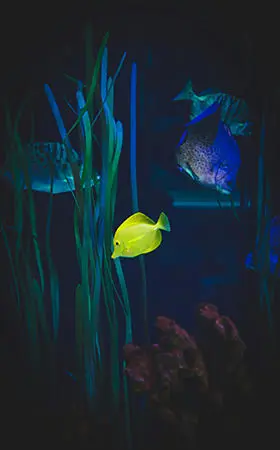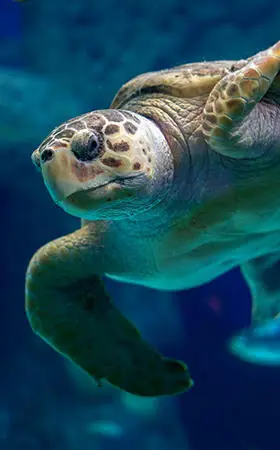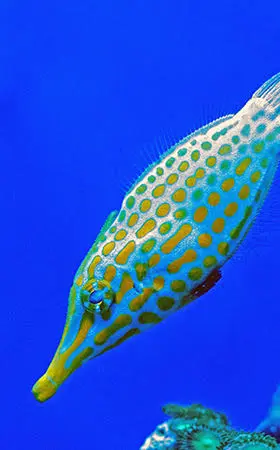
Seaweed and microalgae harbor untapped potential in promoting the well-being and health of animals, offering a resource that can ease the work of zoo and aquarium managers.
Discover their nutritional benefits, their immune system boosting functionalities, their capacity to balance out nutritional deficiencies and how they represent a natural sustainable alternative to conventional feed.
 |
The Power of Microalgae and Seaweed NutritionThe key to maintaining thriving fish lies not only in proper care but also in a well-balanced and nutrient-rich environment. One often underestimated strategy to boost the health of aquarium fish is the incorporation of microalgae and seaweed into their diet.
Algae (microalgae and seaweed) serve as a nutritional powerhouse for fish. Rich in essential fatty acids, vitamins, and minerals, microalgae contribute to the overall well-being of aquarium inhabitants. Not only do they enhance the vibrancy of fish colors, but they also play a crucial role in supporting growth and reproductive health. Omega-3 fatty acids, particularly DHA and EPA, found abundantly in microalgae, are known to promote heart health and improve immune function in fish. Nutritional Balance: Algae are rich in essential nutrients, including proteins, lipids, vitamins, and minerals. Incorporating algae-based feeds into the diet can contribute to achieving a more balanced and nutritionally complete diet for fish, addressing specific dietary needs. Here a short selection of algae: |
||
-
Chlorella:
Chlorella is a green microalga that is known for its high protein content, essential amino acids, vitamins (including B vitamins), minerals (such as iron and zinc), and antioxidants. It is often used as a nutritional supplement for its potential health benefits.
-
Spirulina (Arthrospira platensis):
Spirulina is a blue-green microalga that is rich in protein, particularly essential amino acids. It also contains vitamins (B vitamins and vitamin E), minerals (iron, magnesium, and potassium), and pigments with antioxidant properties (Phycocyanin). Spirulina is commonly used as a supplement in both human and animal diets.
-
Dunaliella salina:
Dunaliella is a type of green microalga known for its high beta-carotene content. Beta-carotene is a precursor to vitamin A, an essential nutrient for fish health. Dunaliella also contains other carotenoids, providing additional antioxidant benefits.
-
Laminaria, Fucus, Ascophyllum (Brown seaweeds):
Kelp is a type of brown algae that is rich in vitamins (including B vitamins and vitamin K), minerals (such as iodine, calcium, and magnesium), and fiber. It is often used in aquaculture as a feed supplement to enhance the nutritional profile of fish diets.
-
Ulva (Green Seaweed):
Ulva, also known as sea lettuce, is a green seaweed that is rich in protein, vitamins (including vitamin C), and minerals (such as iron and potassium). Including Ulva in fish diets can contribute to a well-rounded nutritional profile.
-
Schizochytrium sp.:
This microalga is commonly used as a source of DHA. It is rich in omega-3 fatty acids and is often included in aquafeed formulations to enhance the DHA content of the diet. Schizochytrium-derived oil is a valuable source of DHA for fish.
-
Nannochloropsis sp.:
Nannochloropsis is a microalga that contains omega-3 fatty acids, including EPA and DHA (high EPA content). It is known for its high lipid content and is used in aquaculture as a source of essential fatty acids. Nannochloropsis-derived oil is often incorporated into fish diets.
These algae can be incorporated into fish diets in various forms, including dried and ground into a powder or incorporated into pellets. Additionally, the use of a combination of different algae sources may further enhance the overall nutritional balance of the diet.
Seaweeds, or macroalgae, offer a valuable source of nutrients and can act as a natural immune system booster for aquarium fish. Packed with antioxidants, vitamins, and minerals, seaweed helps fortify the immune response, making fish more resilient to potential diseases. Additionally, seaweed can provide dietary fiber, aiding in digestion and preventing common issues such as bloating. As part of a well-rounded diet, seaweed contributes to the overall health and vitality of aquarium fish. Prebiotics and Probiotics:: While algae themselves are not typically considered direct sources of prebiotics or probiotics, certain components of algae can contribute to gut health and serve as potential prebiotic or immunostimulatory agents. Prebiotics are substances that promote the growth of beneficial microorganisms in the gut, while probiotics are live beneficial microorganisms. Here are some algae-related components that may have prebiotic or immunostimulatory properties: |
 |
||
-
Algal Polysaccharides:
Certain algae produce polysaccharides, such as carrageenan (red seaweeds like Chondrus crispus), agar (red seaweeds like Gelidium), and alginate (brown seaweeds like Laminaria). While not traditional prebiotics, these compounds may have prebiotic-like effects by providing substrates for the growth of beneficial gut bacteria.
-
Fucoidans:
Fucoidans are complex polysaccharides found in brown algae (e.g.,Fucus, Undaria). They have been studied for their potential immunostimulatory and anti-inflammatory properties. While not classic prebiotics, they may support gut health indirectly by modulating the immune system.
-
Laminarins:
Laminarins (from brown seaweeds like Laminaria) are beta-glucans found in brown algae. Beta-glucans are known for their immunostimulatory effects and may contribute to the modulation of the gut immune system, promoting a healthier microbial balance.
-
Spirulina (Arthrospira):
While Spirulina is not an algae in the strict botanical sense, it is often included here for its potential health benefits. Spirulina contains various polysaccharides and bioactive compounds that may have immunomodulatory effects. These compounds could indirectly support gut health.
-
Microalgae-Derived Compounds:
Some microalgae produce bioactive compounds with potential health benefits. For example, certain strains of microalgae (like Chlorella) and cyanobacteria (like Spirulina) produce exopolysaccharides that might have prebiotic effects by promoting the growth of beneficial gut bacteria.
The development of algae-based products for promoting gut health in fish is an active area of investigation within the aquaculture industry.
Disease Resistance:
While algae themselves are not direct agents for disease resistance in fish, certain algae or algal compounds may have properties that can indirectly support the immune system and overall health, contributing to disease resistance. Here are five algae-related components that may have potential benefits for disease resistance:
-
Chlorella:
Chlorella is a green microalga that contains various bioactive compounds, including polysaccharides and antioxidants. Some studies suggest that these compounds may have immunostimulatory effects, potentially enhancing the overall immune response in fish.
-
Spirulina:
Spirulina, a blue-green microalga, contains phycocyanin, a pigment with antioxidant and anti-inflammatory properties. While not a direct disease resistance agent, the antioxidant and anti-inflammatory effects of spirulina may contribute to the overall health of fish, potentially supporting their ability to resist diseases.
-
Fucoidans (Brown Algae):
Fucoidans are complex polysaccharides found in brown algae. These compounds have been studied for their immunomodulatory and antiviral properties. While the research is still in the early stages, fucoidans show promise in supporting immune function in fish.
-
Astaxanthin (Haematococcus pluvialis):
Haematococcus pluvialis is a microalga that produces astaxanthin, a carotenoid with strong antioxidant properties. Astaxanthin has been studied for its potential to enhance the immune response in fish, although more research is needed to understand the specific mechanisms.
-
Beta-Glucans (Various Algae):
Beta-glucans are polysaccharides found in the cell walls of certain algae, including brown algae. Beta-glucans are known for their immunostimulatory effects and have been studied for their potential to enhance the immune system in fish, promoting disease resistance.
While these algae-related components show promise in supporting aspects of the immune system, it's crucial to note that disease resistance in fish is a complex interplay of various factors, including genetics, environment, and overall husbandry practices.
 |
Specialized Diets: Algae-based feeds can be formulated to meet the specific dietary requirements of different fish species. This can be especially important for species with unique nutritional needs, contributing to a more tailored and species-appropriate diet. Omega-3 fatty acids, particularly EPA (eicosapentaenoic acid) and DHA (docosahexaenoic acid), are essential for the health of fish, as they play crucial roles in various physiological processes, including immune function and inflammation regulation. Here are five algae sources that are known for their omega-3 fatty acid content: |
||
-
Schizochytrium sp.:
This microalga is commonly used as a source of DHA. It is rich in omega-3 fatty acids and is often included in aquafeed formulations to enhance the DHA content of the diet. Schizochytrium-derived oil is a valuable source of DHA for fish.
-
Nannochloropsis sp.:
Nannochloropsis is a microalga that contains omega-3 fatty acids, including mostly EPA. It is known for its high lipid content and is used in aquaculture as a source of essential fatty acids. Nannochloropsis-derived oil is often incorporated into fish diets.
-
Isochrysis sp.:
Isochrysis is a type of microalga that contains DHA, an important omega-3 fatty acid. It is commonly used in aquaculture as a source of essential fatty acids, contributing to the nutritional profile of fish diets.
-
Phaeodactylum tricornutum (Diatom):
This diatom species is known for its omega-3 fatty acid content, including EPA. It is often used in aquafeed formulations to provide a source of essential fatty acids, contributing to the overall health of fish.
These algae can be cultivated and processed to extract oils rich in omega-3 fatty acids, which are then incorporated into fish diets. Including these algae sources in the diet of farmed fish helps ensure that they receive the essential EPA and DHA needed for optimal growth, development, and immune function.
Carotenoids and pigments play a crucial role in fish health, providing coloration and acting as antioxidants. Algae are natural sources of these compounds. Here are five algae known for their carotenoid and pigment content:
-
Dunaliella salina:
Dunaliella salina is a green microalga known for its high beta-carotene content. Beta-carotene is a precursor to vitamin A and a carotenoid that contributes to the orange and red coloration in fish. Including Dunaliella in the diet can enhance the coloration of fish, molluscs and corals and provide antioxidant benefits.
-
Spirulina:
Spirulina is a blue-green microalga that contains a variety of pigments, including chlorophyll, phycocyanin, and beta-carotene. These pigments contribute to the green-blue coloration of Spirulina and can enhance the coloration of fish. Spirulina is commonly used in aquaculture to improve the visual appearance of fish.
-
Haematococcus pluvialis:
Haematococcus pluvialis is a green microalga that is particularly rich in astaxanthin, a carotenoid responsible for the pink to reddish coloration observed in certain fish, crustaceans, and other aquatic organisms. Astaxanthin is a powerful antioxidant that contributes to the health of fish.
-
Chlorella:
Chlorella is a green microalga that contains various pigments, including chlorophyll, lutein, and zeaxanthin. While not as rich in carotenoids as some other algae, Chlorella can contribute to the overall pigment content in fish diets.
-
Porphyridium cruentum:
Porphyridium cruentum is a red microalga that produces zeaxanthin (carotenoid: it has a typical yellow colour, which can also be found in corn) and phycoerythrin (red phycobiliprotein). Including Porphyridium in fish diets can enhance the red coloration of fish and provide antioxidant benefits.
These algae can be incorporated into fish diets in various forms, including dried and ground into a powder or included in formulated pellets. The pigments derived from these algae contribute to the visual appeal of fish and may also provide health benefits due to their antioxidant properties.
Sustainability:Algae-based feeds can be a sustainable alternative to traditional fish meal and fish oil, which are often sourced from wild-caught fish. Cultivating algae is more environmentally friendly and can contribute to reducing the impact of overfishing on marine ecosystems. Addressing sustainability concerns in aquaculture involves finding alternative and eco-friendly sources of nutrients for fish feeds. Algae are considered a sustainable option, as they can be cultivated with relatively low environmental impact compared to traditional sources like fish meal and fish oil. Here are five algae species that contribute to sustainability in aquaculture: |
 |
||
-
Chlorella:
Chlorella is a green microalga known for its rapid growth and ability to thrive in various environments. It has a high yield per unit area, making it a sustainable source of protein (60%) and other nutrients. Chlorella cultivation can be achieved in closed systems, reducing the risk of environmental contamination.
-
Spirulina:
Spirulina is a blue-green microalga that grows well in alkaline water and is highly adaptable to different climates. Its high protein content (>65%), coupled with its ability to be cultivated in non-arable land, makes Spirulina a sustainable option for aquaculture feeds.
-
Ulva (Sea Lettuce):
Ulva is a green seaweed that grows quickly and can be cultivated in coastal areas. It is known for its potential as a biofilter, absorbing excess nutrients from the water. Cultivating Ulva can help improve water quality and provide a sustainable source of nutrients for fish.
-
Porphyra (Nori):
Porphyra is a red seaweed which can be cultivated in integrated multi-trophic aquaculture (IMTA) systems, where it benefits from the nutrients released by finfish farming. This approach promotes sustainability by creating a more balanced and interconnected ecosystem.
-
Gracilaria:
Gracilaria is a red seaweed that can be cultivated in marine environments, including integrated systems with fish farming. It has been used in IMTA systems to absorb excess nutrients, contributing to the sustainability of aquaculture operations.
These algae species offer sustainable alternatives to conventional fish feed ingredients, helping reduce the pressure on wild fish stocks and contributing to the overall environmental responsibility of aquaculture practices. Utilizing algae-based feeds aligns with environmental conservation efforts, and aquariums can use this as an opportunity to educate visitors about sustainable and eco-friendly practices in aquaculture.
In the realm of aquarium management and responsible aquaculture, the integration of microalgae and seaweed emerges as a game-changer. Beyond their role as nutritional powerhouses, these often-overlooked resources enhance fish colors, boost immune systems, and address dietary deficiencies. From Chlorella's high protein content to Spirulina's antioxidant-rich profile, each algae species plays a vital role in promoting fish health. Moreover, by adopting algae-based feeds, aquariums contribute to sustainable practices, offering a responsible alternative to conventional fish meal and oil. This holistic approach not only ensures vibrant aquariums but also aligns with environmental conservation, making it a promising avenue for the future of aquatic well-being and responsible aquaculture.